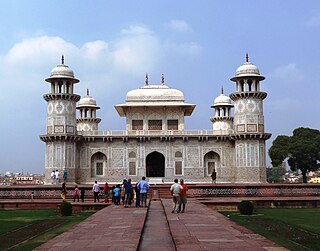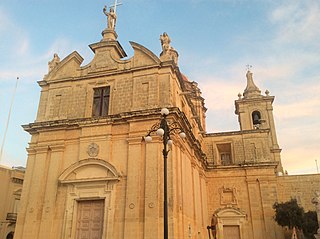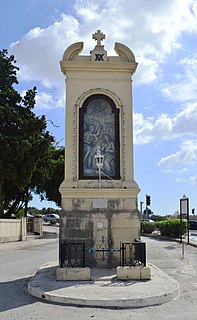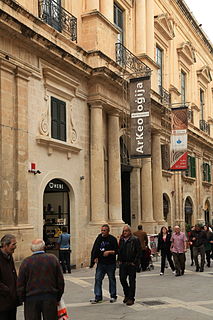
Catacombs are man-made subterranean passageways for religious practice. Any chamber used as a burial place is a catacomb, although the word is most commonly associated with the Roman Empire.

A tomb is a repository for the remains of the dead. It is generally any structurally enclosed interment space or burial chamber, of varying sizes. Placing a corpse into a tomb can be called immurement, and is a method of final disposition, as an alternative to cremation or burial.

The Catacombs of Rome are ancient catacombs, underground burial places in and around Rome, of which there are at least forty, some rediscovered only in recent decades. Though most famous for Christian burials, either in separate catacombs or mixed together, Jews and also adherents of a variety of pagan Roman religions were buried in catacombs, beginning in the 2nd century AD, occasioned by the ancient Roman ban on burials within a city, and also as a response to overcrowding and shortage of land. The most extensive and perhaps the best known is the Christian Catacomb of Callixtus located near the Park of the Caffarella, but there are other sites, both Christian and not, scattered around the city, some of which are now engulfed in the modern urban sprawl.

Mosta is a small but densely populated town in the Northern Region of Malta. The most prominent building in Mosta is the Rotunda, a large basilica built by its parishioners' volunteer labour. It features the world's 3rd largest unsupported dome, and displays a replica of a German bombshell that famously crashed through the dome but did not detonate upon impact.

The Xagħra Stone Circle, also known as the Xagħra Hypogeum or the Brochtorff Circle, is a Neolithic funerary complex located in Xagħra, Gozo, Malta. It consists of a series of caves which were used to bury the dead, and which were surrounded by a walled enclosure. It mainly dates back to around 3000 to 2400 BC, although the earliest tombs at the site date back to 4100 to 3800 BC. The caves collapsed sometime before 2000 BC, and the site was later used for domestic and agricultural purposes.

Qrendi is a small village in the Southern Region of Malta, with a population of 2752 people as of March 2014. It is located close to Mqabba, Żurrieq and Siggiewi. Within its boundaries are two well-known Neolithic temples called Mnajdra and Ħaġar Qim. In this village two feasts are held annually. The feast of Our Lady of Lourdes is celebrated either on the last Sunday of June or on the first Sunday of July, with 15 August the titular feast of the Ascension of Our Lady. This feast is popularly known as the feast of Santa Maria.

Mqabba is a town in the Southern Region of Malta. It has a traditional Maltese village layout, with a population of about 3,300 inhabitants. The focal point is the Parish Church of the Assumption, found at the core of the village. It has two band clubs, a number of gardens and a list of national monuments.

A hypogeum or hypogaeum is an underground temple or tomb.

The Punic religion, Carthaginian religion, or Western Phoenician religion in the western Mediterranean was a direct continuation of the Phoenician variety of the polytheistic ancient Canaanite religion. However, significant local differences developed over the centuries following the foundation of Carthage and other Punic communities elsewhere in North Africa, southern Spain, Sardinia, western Sicily, and Malta from the ninth century BC onward. After the conquest of these regions by the Roman empire in the third and second centuries BCE, Punic religious practices continued, surviving until the fourth century CE in some cases. As with most cultures of the ancient Mediterranean, Punic religion suffused their society and there was no stark distinction between religious and secular spheres. Sources on Punic religion are poor. There are no surviving literary sources and Punic religion is primarily reconstructed from inscriptions and archaeological evidence. An important sacred space in Punic religion appears to have been the large open air sanctuaries known as tophets in modern scholarship, in which urns containing the cremated bones of infants and animals were buried. There is a long-running scholarly debate about whether child sacrifice occurred at these locations, as suggested by Greco-Roman and biblical sources.

The Catacombs of San Gennaro are underground paleo-Christian burial and worship sites in Naples, Italy, carved out of tuff, a porous stone. They are situated in the northern part of the city, on the slope leading up to Capodimonte, consisting of two levels, San Gennaro Superiore, and San Gennaro Inferiore. The catacombs lie under the Rione Sanità neighborhood of Naples, sometimes called the "Valley of the Dead". The site is now easily identified by the large church of Madre del Buon Consiglio.

Tal-Barrani is a primarily agricultural area in Malta that extends from the town of Żejtun to the villages of Santa Luċija, Ħal Tarxien and Ħal Għaxaq, lying across many south-eastern communities in Malta. The land gives its name to a nearby chapel dedicated to Saint Lucy. In a notarial document dating from the 16th century, the area near this estate was known as bitalbarrani, that is, the stranger's or outsider's land. This name may indicate that the land under cultivation at Tal-Barrani belonged to some outsider, either someone from outside a village community, or a foreigner. Moreover, the same land contained another area which was called Tal-Misilmin. At least from the 17th century onwards, Tal-Barrani was a recognised agricultural estate, and was documented in the 1654 property book of the Order of St. John, the Cabreo Magisteriale.

The National Museum of Archaeology is a Maltese museum in Valletta, with artefacts from prehistory, Phoenician times and a notable numismatic collection. It is managed by Heritage Malta.

St. Paul's Catacombs are some of the most prominent features of Malta's early Christianity archeology. The archeological clearing of the site has revealed an extensive system of underground galleries and tombs dating from the third to the eighth centuries CE.
The Abbatija Tad-Dejr hypogeal complex is a paleochristian burial site in Rabat, Malta.

The Salina Catacombs are a cluster of small catacombs located near the Church of the Annunciation in Salina, Naxxar, in Malta. Although small when compared to the catacombs of St. Paul and St. Agatha in Rabat, they are an important record of the sizeable community that must have lived in the area in around the last half of the first millennium AD.

There are hundreds of catacombs in Malta, principally found in Mdina, the former capital of the island. The catacombs are very small, but are in good preservation.

The Catacomb of Saint Thecla is a Christian catacomb in the city of Rome, near the Via Ostiense and the Basilica of Saint Paul Outside the Walls, in the southern quarter of the ancient city. The catacomb was constructed in the fourth century of the Common Era, linked with a basilica to the saint that is alluded to in literature. Because of the enigmatic endings of the legends of Saint Thecla of Iconium, it is still unknown whether the tomb belongs to the saint or if it belongs to a different noblewoman. Regardless, the tomb is an example of early Christian funerary practice and artwork. The most recent discovery in the catacomb was the depiction of several apostles, hypothesized to be their earliest portrayals. Of particular interest to many is the portrait of the Apostle Paul.
The Hypogeum of Vibia is part of a small complex of pagan burial chambers in Rome which were constructed along the Via Appia in the late 4th century CE. It is named for the burials of a woman named Vibia and her husband Vincentius, a priest of the Thraco-Phrygian god Sabazios. The hypogeum is notable for the paintings that show the deceased figures in mythological scenes and in the underworld, and for their accompanying inscriptions. Numerous other decorated tombs and inscriptions were found in the complex.

The Għar Għerduf catacombs at Ta' Kerċem, also known as Għar Gerduf, are the only surviving early Christian catacombs or paleochristian hypogea in Gozo, Malta. Għar Għerduf is a unique Roman burial site in Gozo, which has for centuries attracted the attention of scholars interested in Maltese archaeology. The site was visited by erudite visitors who often included a description of the place as they did for Ġgantija and the Xagħra Stone Circle.
The Ħal Resqun catacombs at Gudja, are interpreted as early Christian catacombs or paleochristian hypogea in Malta. The Ħal Resqun catacombs are especially notable for their carved decorations, and other features which are uncommon in Maltese catacombs, and of exceptional value. Some historians have suggested that, unlike other catacombs, those at Ħal Resqun portray enough Christian markers to be classified as paleochristian remains, while others view these features to be inconclusive. Some of the graffiti, interpreted by a number of historians as portraying a biblical scene, are thought to be unique in the world, and considered one of the most important remains from Late Antiquity in Malta.
















